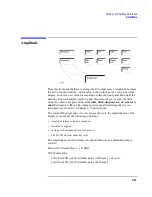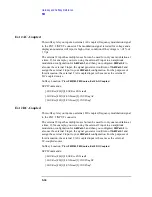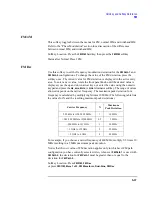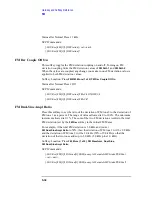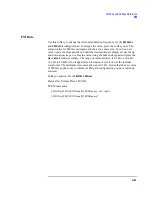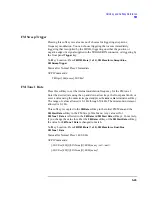
5-37
Hardkey and Softkey Reference
FM
FM/
Φ
M
This softkey toggles between the menus for FM, normal
Φ
M, and wideband
Φ
M.
Refer to the “Phase Modulation” section for a discussion of the differences
between normal
Φ
M, and wideband
Φ
M.
Softkey Location: Press the
FM/
Φ
M
hardkey, then press the
FM/
Φ
M
softkey.
Status after Normal Preset: FM
FM Dev
Use this softkey to set the frequency modulation deviation for the
FM Path 1
and
FM Path 2
configurations. To change the value of the FM deviation, press the
softkey once. The current value for FM deviation is displayed in the active entry
area. To enter a new value, rotate the front panel knob until the desired value is
displayed, use the up and down arrow keys, or enter the value using the numeric
keypad and press the
Hz
,
kHz
,
MHz
, or
GHz
terminator softkey. The range of values
allowed depends on the carrier frequency. The maximum peak deviation for a
frequency is calculated by multiplying N times 10 MHz. (The following table lists
the values for N and the resulting maximum peak deviations.)
For example, if you choose a carrier frequency of 400 MHz, multiply 0.5 times 10
MHz resulting in a 5 MHz maximum peak deviation.
Notice that the new value of FM deviation applies only to whichever FM path
configuration you have currently selected. Also, whenever
FM Path 1
is used with
FM Path 2
, the deviation for
FM Path 1
must be greater than or equal to the
deviation for
FM Path 2
.
Softkey Location: Press
FM/
Φ
M
,
FM Dev
or press
FM/
Φ
M
,
More 1 of 2
,
FM Waveform
,
Dual-Sine
,
FM Dev
Carrier Frequency
N
Maximum
Peak Deviation
250 kHz to
≤
249.999 MHz
1
10 MHz
> 249.999 MHz to
≤
500 MHz
0.5
5 MHz
> 500 MHz to
≤
1 GHz
1
10 MHz
> 1 GHz to
≤
2 GHz
2
20 MHz
> 2 GHz to 4 GHz
4
40 MHz
Summary of Contents for ESG Series
Page 3: ...ii ...
Page 29: ...1 12 Preparing for Use Verifying Signal Generator Operation ...
Page 43: ...2 14 Using Functions Saving and Recalling an Instrument State ...
Page 95: ...3 52 Troubleshooting HP Sales and Service Offices ...
Page 109: ...4 14 Front and Rear Panel Rear Panel Overview ...
Page 111: ...5 2 Hardkey and Softkey Reference ...
Page 135: ...5 26 Hardkey and Softkey Reference Ampl ...
Page 137: ...5 28 Hardkey and Softkey Reference Amplitude ...
Page 139: ...5 30 Hardkey and Softkey Reference Arrow Keys ...
Page 141: ...5 32 Hardkey and Softkey Reference Display Contrast Keys ...
Page 161: ...5 52 Hardkey and Softkey Reference FM ...
Page 169: ...5 60 Hardkey and Softkey Reference Frequency ...
Page 171: ...5 62 Hardkey and Softkey Reference Help ...
Page 173: ...5 64 Hardkey and Softkey Reference Hold ...
Page 175: ...5 66 Hardkey and Softkey Reference Incr Set ...
Page 195: ...5 86 Hardkey and Softkey Reference LF Out ...
Page 197: ...5 88 Hardkey and Softkey Reference Local ...
Page 199: ...5 90 Hardkey and Softkey Reference Mod On Off ...
Page 200: ...5 91 Hardkey and Softkey Reference Mode Mode This front panel key is reserved for future use ...
Page 201: ...5 92 Hardkey and Softkey Reference Mode ...
Page 203: ...5 94 Hardkey and Softkey Reference Numeric Keypad ...
Page 225: ...5 116 Hardkey and Softkey Reference Power Switch ...
Page 235: ...5 126 Hardkey and Softkey Reference Preset ...
Page 241: ...5 132 Hardkey and Softkey Reference Pulse ...
Page 245: ...5 136 Hardkey and Softkey Reference Recall ...
Page 247: ...5 138 Hardkey and Softkey Reference Return ...
Page 249: ...5 140 Hardkey and Softkey Reference RF On Off ...
Page 255: ...5 146 Hardkey and Softkey Reference Save ...
Page 275: ...5 166 Hardkey and Softkey Reference Sweep List ...
Page 311: ...6 10 Options and Accessories Upgrade and Retrofit Kits ...
Page 312: ...7 1 7 Operation This chapter is reserved for future use ...
Page 313: ...7 2 Operation ...
Page 322: ...8 9 Safety and Regulatory Declaration of Conformity Declaration of Conformity ...
Page 341: ...9 18 Specifications HP ESG Series Signal Generators Specifications ...





